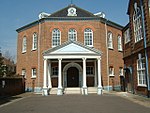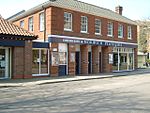St Clement's Church, Norwich
Church of England church buildings in NorwichEnglish church stubsGrade I listed buildings in Norfolk

St Clement's Church, Norwich, also known as St Clement Colegate, is a Grade I listed redundant parish church in the Church of England in Norwich. It is dedicated to St Clement, a popular Danish saint and patron of seafarers.
Excerpt from the Wikipedia article St Clement's Church, Norwich (License: CC BY-SA 3.0, Authors, Images).St Clement's Church, Norwich
Saint Clements Avenue, Norwich New Catton
Geographical coordinates (GPS) Address Website External links Nearby Places Show on map
Geographical coordinates (GPS)
| Latitude | Longitude |
|---|---|
| N 52.633191666667 ° | E 1.2966333333333 ° |
Address
Saint Clement
Saint Clements Avenue
NR3 1BN Norwich, New Catton
England, United Kingdom
Open on Google Maps











